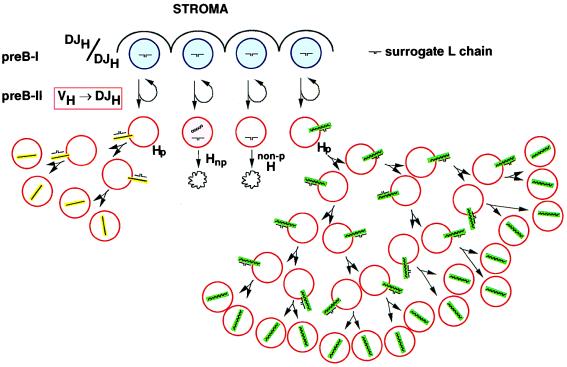Figure 3.
Formation of the pre-B cell receptor and
its effect on B cell development. DJH-rearranged pre-B I
cells (5) in contact with bone marrow stromal cells undergo asymmetric
divisions that yield one cell, which retains contact with stroma and,
thus, pre-B I differentiation status. The other cell loses contact to
stroma, is induced to differentiate to a pre-B II cell in rearranging a
VH to DHJH segment on the H chain
loci. Nonproductive (np) rearrangements leads to μH chain-negative
cells that die ( ). Productive
rearrangements can lead to μH chain that cannot pair with surrogate L
chain (15). Cells with nonpairing μH chains cannot form a pre-B cell
receptor and die. On the other hand, pairing μH chain leads to pre-B
cell receptor expression on the surface, which induces pre-B II cell
proliferation. The higher the avidity, the longer is the proliferative
phase (high avidity = green, low avidity = yellow). In the
simplest form of this model, the surrogate L chain assumes a ligand
function for the μH chain to induce proliferation, hence,
an external ligand binding to VpreB and/or VH
must not necessarily be present to induce clonal expansion of pre-B
cell receptor-expressing pre-B II cells.
). Productive
rearrangements can lead to μH chain that cannot pair with surrogate L
chain (15). Cells with nonpairing μH chains cannot form a pre-B cell
receptor and die. On the other hand, pairing μH chain leads to pre-B
cell receptor expression on the surface, which induces pre-B II cell
proliferation. The higher the avidity, the longer is the proliferative
phase (high avidity = green, low avidity = yellow). In the
simplest form of this model, the surrogate L chain assumes a ligand
function for the μH chain to induce proliferation, hence,
an external ligand binding to VpreB and/or VH
must not necessarily be present to induce clonal expansion of pre-B
cell receptor-expressing pre-B II cells.

